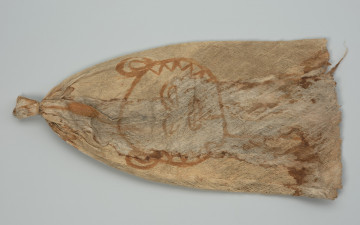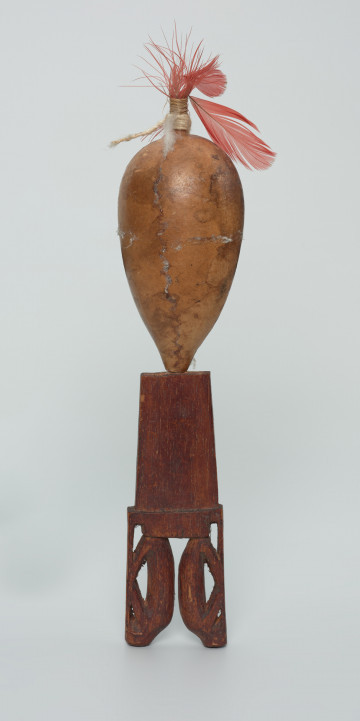
Mask of jaguar
około 1960
National Museum in Szczecin
Part of the collection: Crafts of the Amazon Indians
The mae de vento mask symbolises the forces and spirits that inhabit the rainforest. It was used for the ‘wind dance’ performed during initiation rituals by the Tukúna Indians from Brazil. The mask is made from the inner layer of the bark of trees and bushes, a material commonly called tapa, or tururý by the Tukúna Indians. The masks are made exclusively by men, who also wear them during dances. The prepared tapa is covered with natural dyes and richly decorated. In addition to traditional motifs representing the forces of nature and animals, they also have drawings of aeroplanes, ships and cars. Tukúna masks have one thing in common - they never have cut-outs for eyes. Borys Malkin, the famous Polish ethnologist and Americanist, described the difficulties of the dancers during the Tukúna mask dance as follows (...) the dancers would trip and bump into each other, bobbing their grotesque heads back and forth while shouting something. Sometimes they bumped heads, and sometimes they jumped away from each other. Sometimes someone fell on the muddy patch. Wild screams and laughter accompanied that. The masks worn during a girl's initiation symbolise the spirits that are supposed to protect the main character of the festival. Dancing with them, she learns how to cope with the dangers of adult life. Girls who experience menstruation for the first time undergo initiation. The adept is prepared for adulthood by older Indian women, who tell her myths and stories about the Tukúna people. After the period of isolation, a big celebration is organised in honour of the girl, in which the whole village takes part. The clan markings are put on the young Indian girl's face, and her body is covered with black dye. The initiation is a rite of passage, which in the Tukúna culture involves a trial of pain. A young adept has tufts of hair pulled out of her head, believing that the ritual's pain will help her endure childbirth more quickly in the future. The girls willingly undergo this procedure, because otherwise they would not be considered "full-fledged" women.
Katarzyna Findlik-Gawron
Author / creator
Dimensions
cały obiekt: height: 25 cm, width: 32,5 cm
Creation time / dating
Creation / finding place
Identification number
Location / status

około 1960
National Museum in Szczecin

circa 1990 — 2000
National Museum in Szczecin

około 1987
National Museum in Szczecin
DISCOVER this TOPIC
Castle Museum in Łańcut
DISCOVER this PATH
Educational path